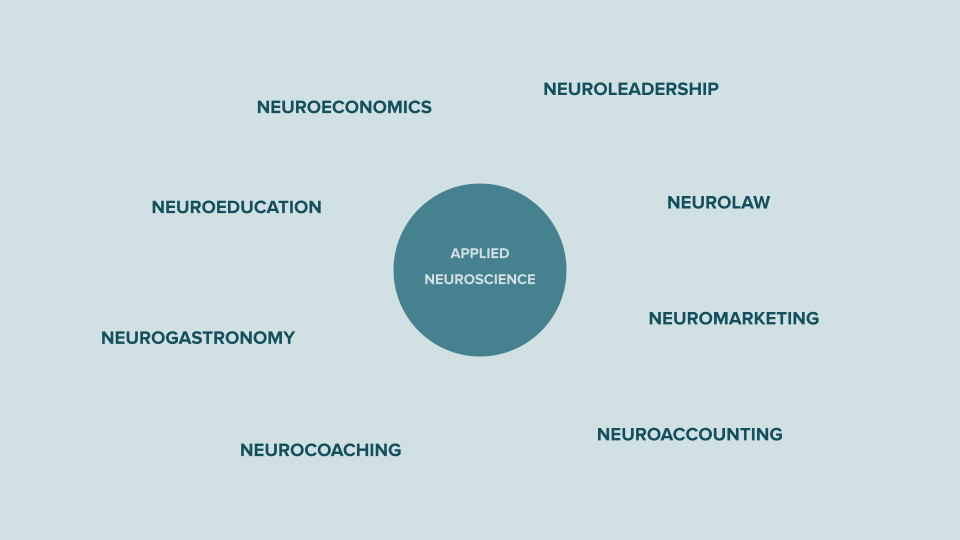There are many different fields of research in neuroscience. Molecular and cellular neuroscience explores how neurons express and respond to molecular signals, and how they process signals at a physiological and electrochemical level. Cognitive and behavioural neuroscience explores the neurobiological processes that underlie cognition and behaviour. Computational neuroscience uses mathematical models to understand the features that govern the nervous system. What about applied neuroscience?
Applied neuroscience explores the applications of neuroscience in real-world settings. Where most of the work in other neuroscientific branches is done in an academic setting, applied neuroscience is used by practitioners — professionals who work in clinics, hospitals, labs, schools, and companies — as a way to support their core discipline.
A multidisciplinary field
As its goal is to take neuroscience out of the lab and into the real world, applied neuroscience draws knowledge from many areas of science, from psychology to molecular biology. In addition, the discipline includes some specialised subfields.
For example, the goal of educational neuroscience (or “neuroeducation”) is to develop evidence-based teaching and learning practices based on neuroscience. Researchers in educational neuroscience investigate the neural mechanisms of reading, attention, numerical cognition, as well as learning difficulties linked to neurodevelopmental conditions that may lead to cognitive impairments relevant to education.
Another subfield is neuromarketing. As you probably guessed, neuromarketing is the application of neuroscience to marketing. Eben Harrell describes neuromarketing as “the measurement of physiological and neural signals to gain insight into customers’ motivations, preferences, and decisions, which can help inform creative advertising, product development, pricing, and other marketing areas.”
You also have organizational neuroscience. Dr Angela Passarelli explains: “Organizational neuroscience is an emerging research domain within the field of management that integrates organizational behavior with neuroscience. Stimulated by recent advances in neuroimaging, organizational neuroscience involves the identification of neural substrates and their functioning as they relate to social-cognitive phenomena in organizational contexts.”
And the list goes on… Other subfields of applied neuroscience include neuroleadership, neuroeconomics, neurocoaching, neurogastronomy, neurolaw, and a myriad more disciplines attempting to apply neuroscience in a real-world setting.
Beware of neurononsense
Many practitioners of these fields are genuinely attempting to apply findings from basic neuroscience research without inflating the strength of the link between what is found in the lab and what can be expected to happen in a messy, uncontrolled real-world environment. But there is a lot of snake oil out there. Some people call it “the neuro sell”, others call it “neurobullshit”, “neurocrap”, or more politely “neurononsense” — but the idea is the same: just by slapping “neuro” in front of a word does not make it an evidence-based field of practice.
Some researchers and practitioners have come together to try and encourage good practice in the field of applied neuroscience. The Society of Applied Neuroscience (SAN) is a nonprofit membership organisation which publishes articles and hosts conferences to discuss best practice and the latest research. The Institute for Applied Neuroscience (IAN) is an independent, nonprofit research and training organisation whose goal is to help translate neuroscience research into real-world solutions in the fields of education, healthcare, law, business, and leadership.
Naomi Glover, co-founder of the Applied Neuroscience Association (ANA), explains: “Neuromyths can be defined as strongly held misconceptions about the brain. They generally emerge from generalisations or distortions of the scientific data and are frequently proliferated in the media, leading to wasted time, effort, and money. By improving neuroscience literacy, applied neuroscience practitioners can help dispel those myths, and improve access to evidence-based approaches to improve support in education and the workplace.”
If you want to learn more about the field without falling into the trap of neuromyths, studying applied neuroscience from trustworthy sources can be a great way to get started.
How to study applied neuroscience
There are many reputable institutions offering applied neuroscience courses. If you want a taster, MIT offers an applied neuroscience certificate, which covers topics such as the neural pathways that underlie procrastination and resilience, as well as evidence-based strategies to better manage your cognitive resources.
If you are able to invest more time, energy, and money, some universities offer degrees in applied neuroscience. Some of these degrees are available to study online. The School of Advanced Education, Research and Accreditation offers a one-year Master degree in applied neuroscience, which is only open to professionals in neurosciences or health sciences, though they may accept alternative qualifications.
The Institute of Psychiatry, Psychology and Neuroscience at King’s College has an Applied Neuroscience Postgraduate Diploma and MSc course, which can be completed between 16 months to six years, depending on your time commitment and the number of modules you take.
If you are able to relocate, the Royal Holloway University of London provides an in-person Applied Neuroscience MSc course, which requires a psychology or a related degree with evidence of having taken methodological and statistics training.
If you don’t have a psychology or neuroscience degree, Dundee University still allows you to join their Applied Neuroscience MSc programme as long as you start the course by taking a Fundamentals of Neuroscience module. You will then be able to combine your neuroscientific knowledge with aspects of psychology, business, or marketing, and complete a laboratory- or industry-based research project.
As you can see, there are a variety of ways to study applied neuroscience, and not all programmes have the same requirements. In addition, you may want to explore a specific branch of applied neuroscience — such as neuroeducation, neuroleadership, neuromarketing, or neurogastronomy — but, again, be careful: there are lots of dubious accreditations out there, offered by institutions that care more about emptying your pockets than filling your brain with useful knowledge.
Applied neuroscience is in its infancy, with all the limitations such an early stage implies. It also means there are lots of opportunities to contribute to the field and shape its future direction. Whether you decide to join an association, study with an institution, or go the self-education route, the key is — pun intended — to apply what you learn!

